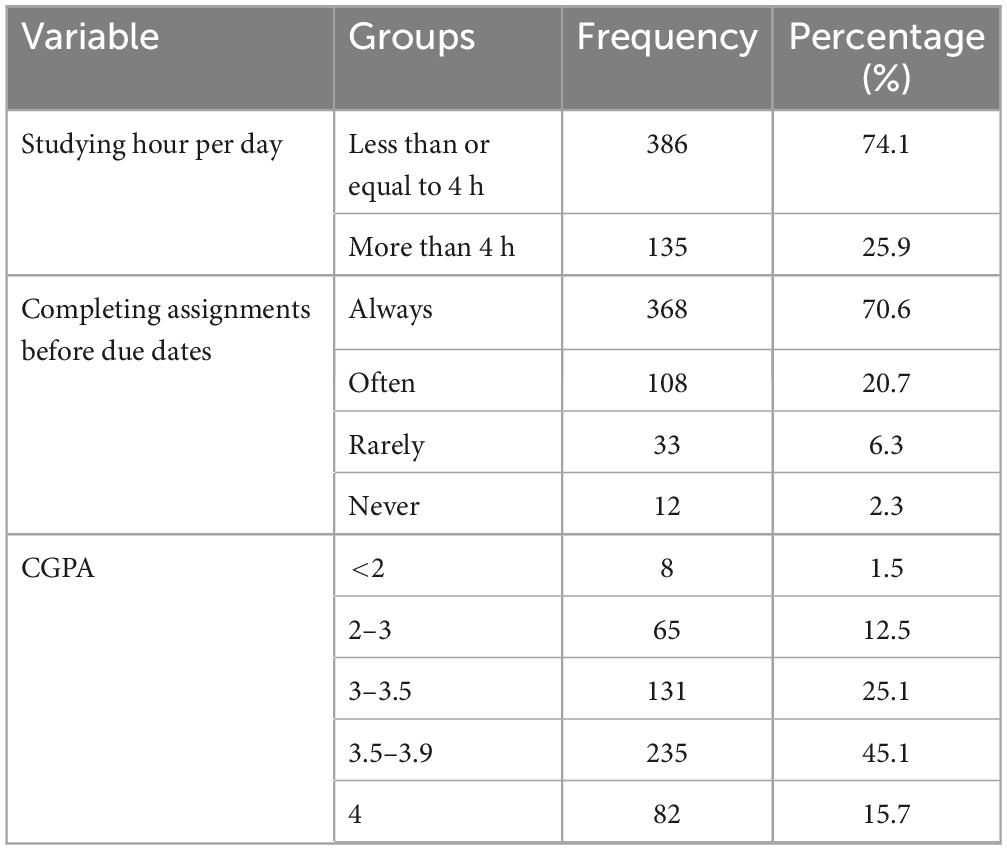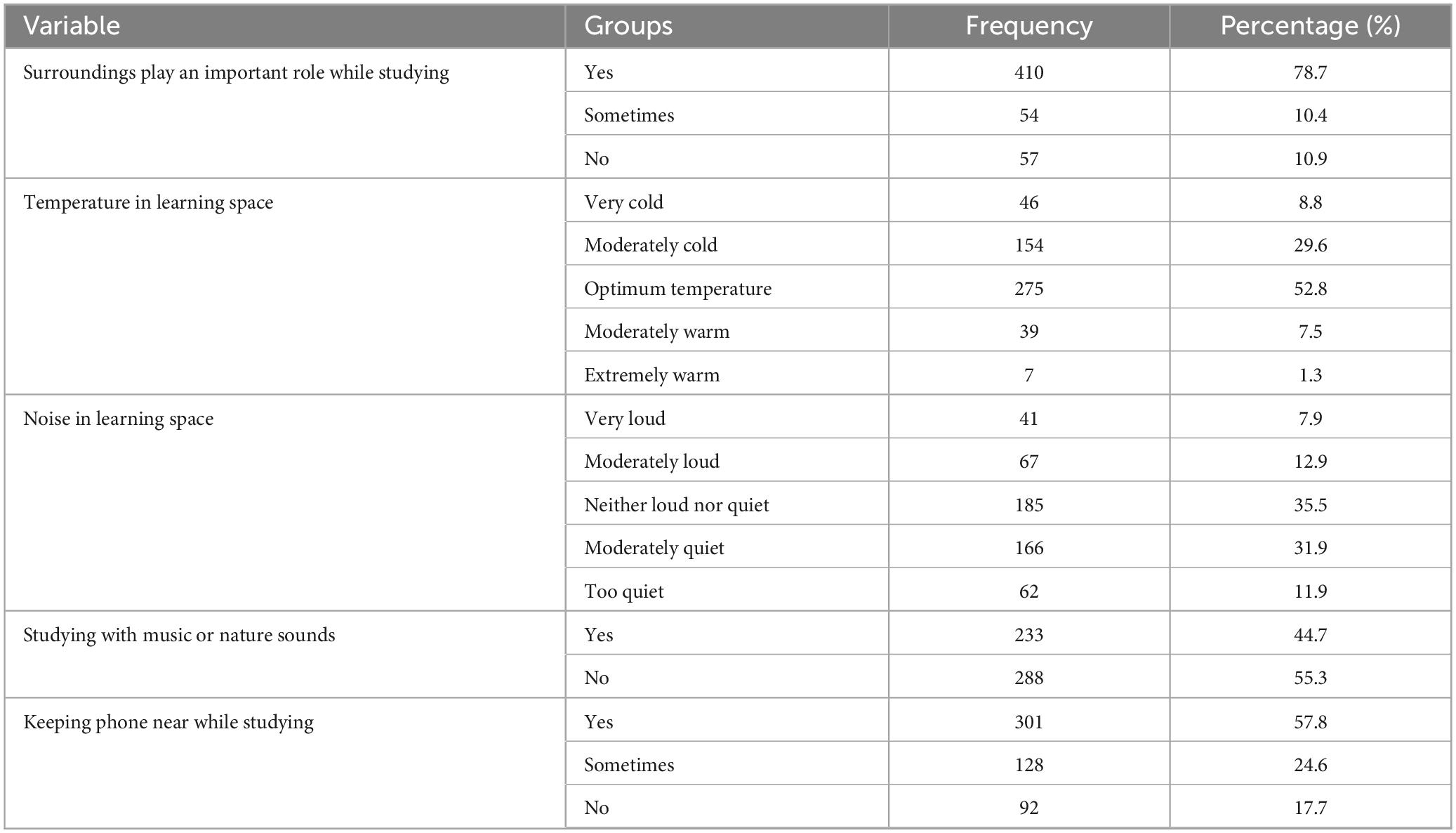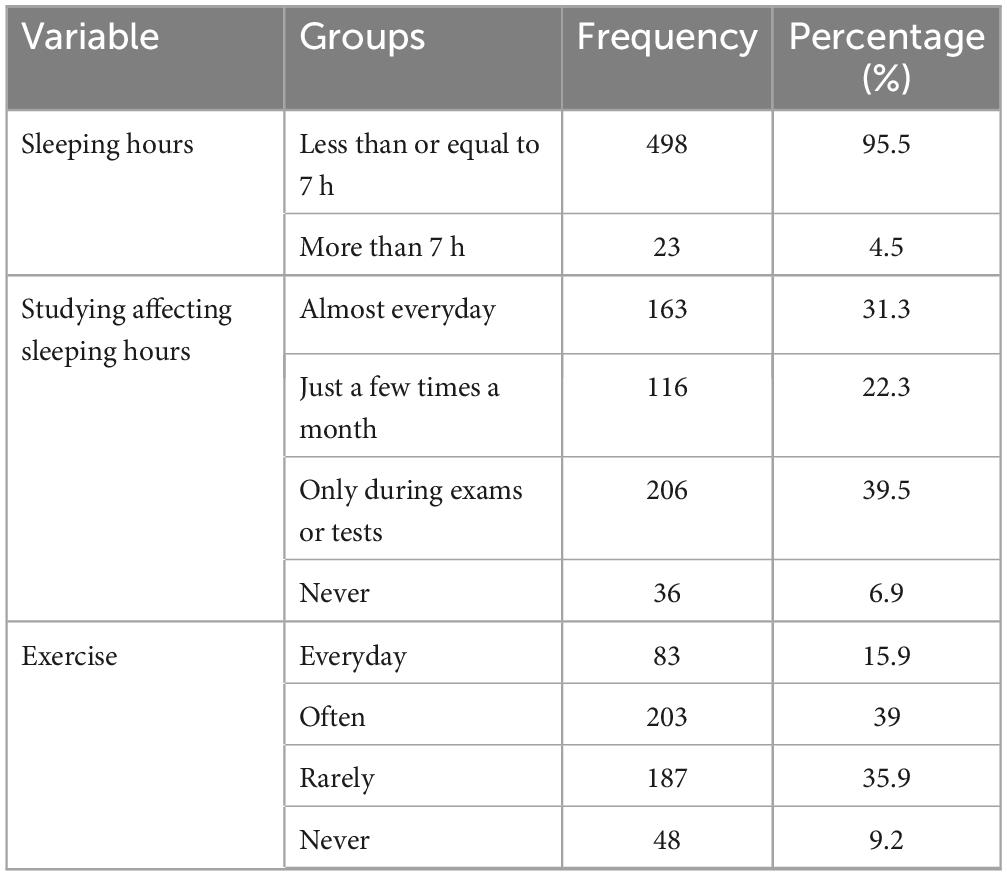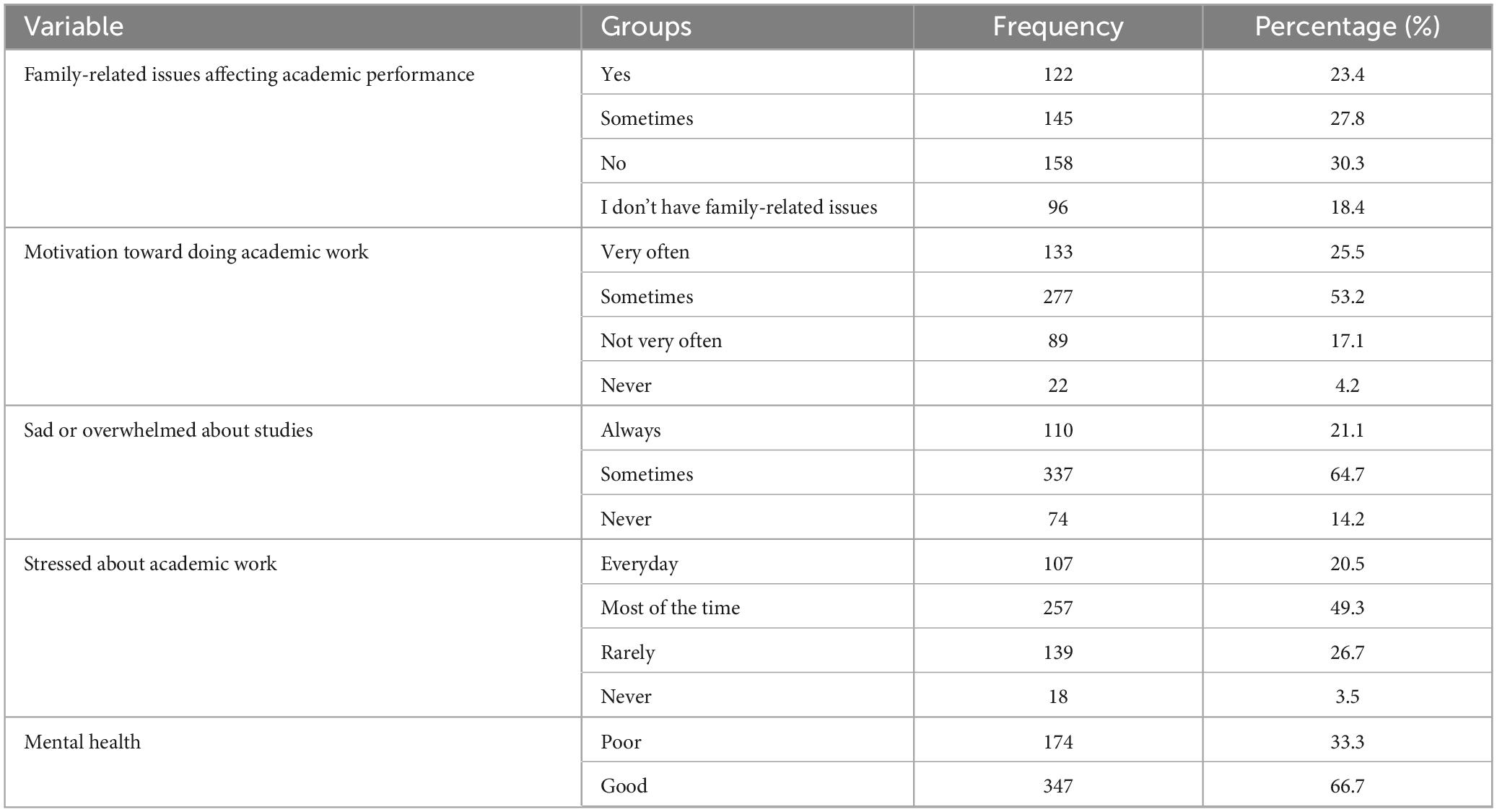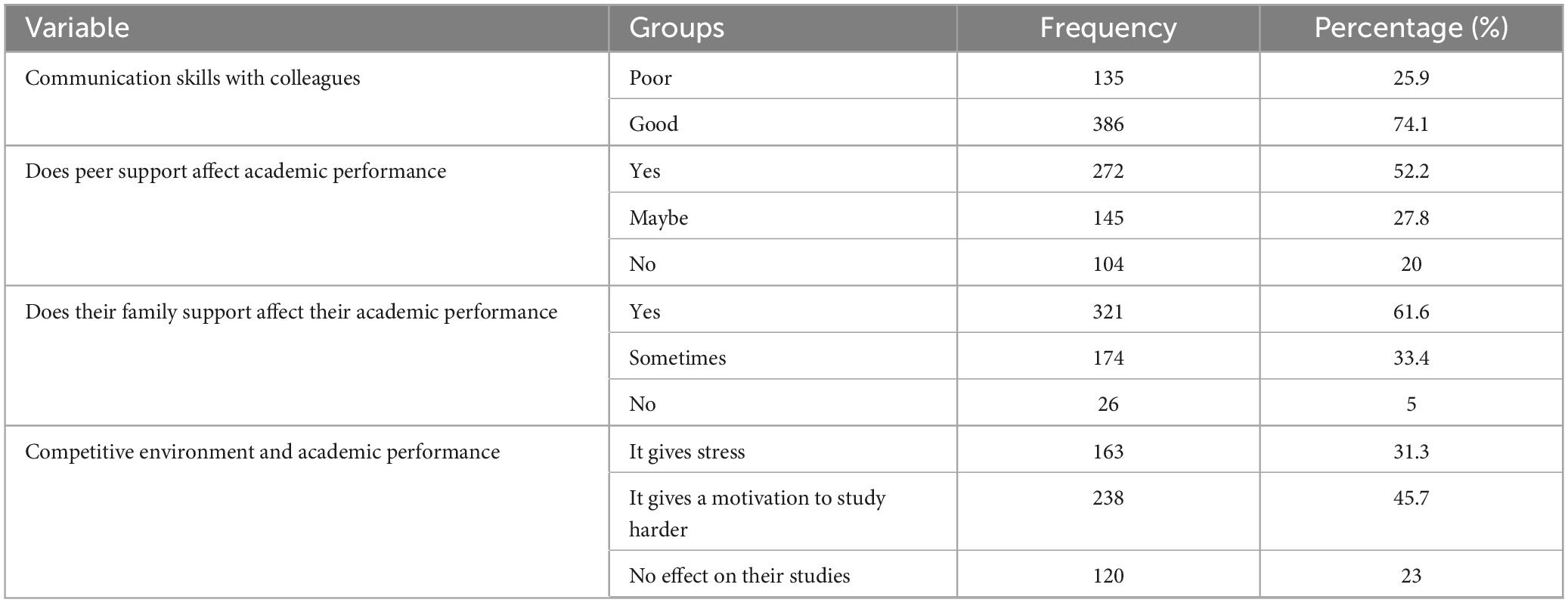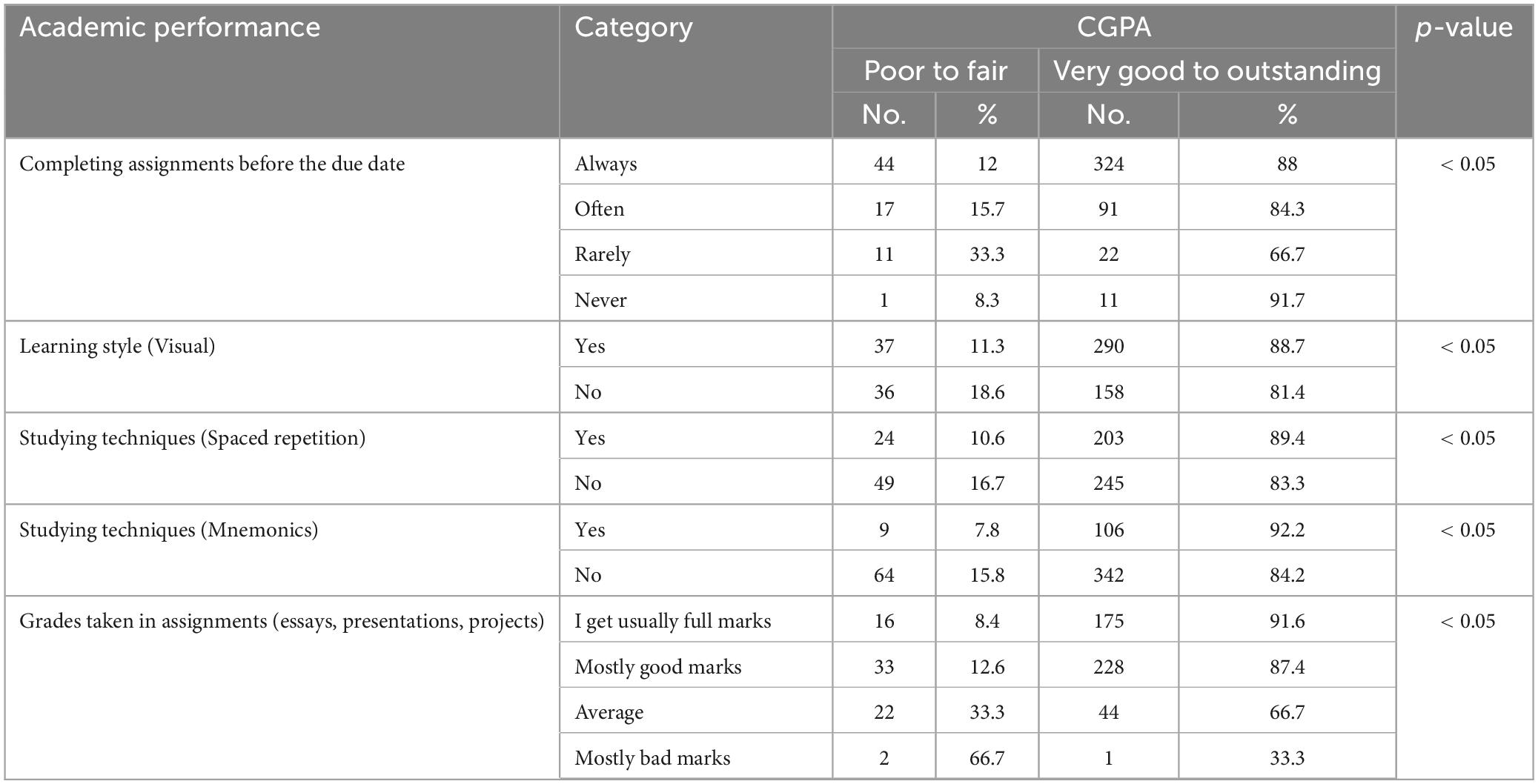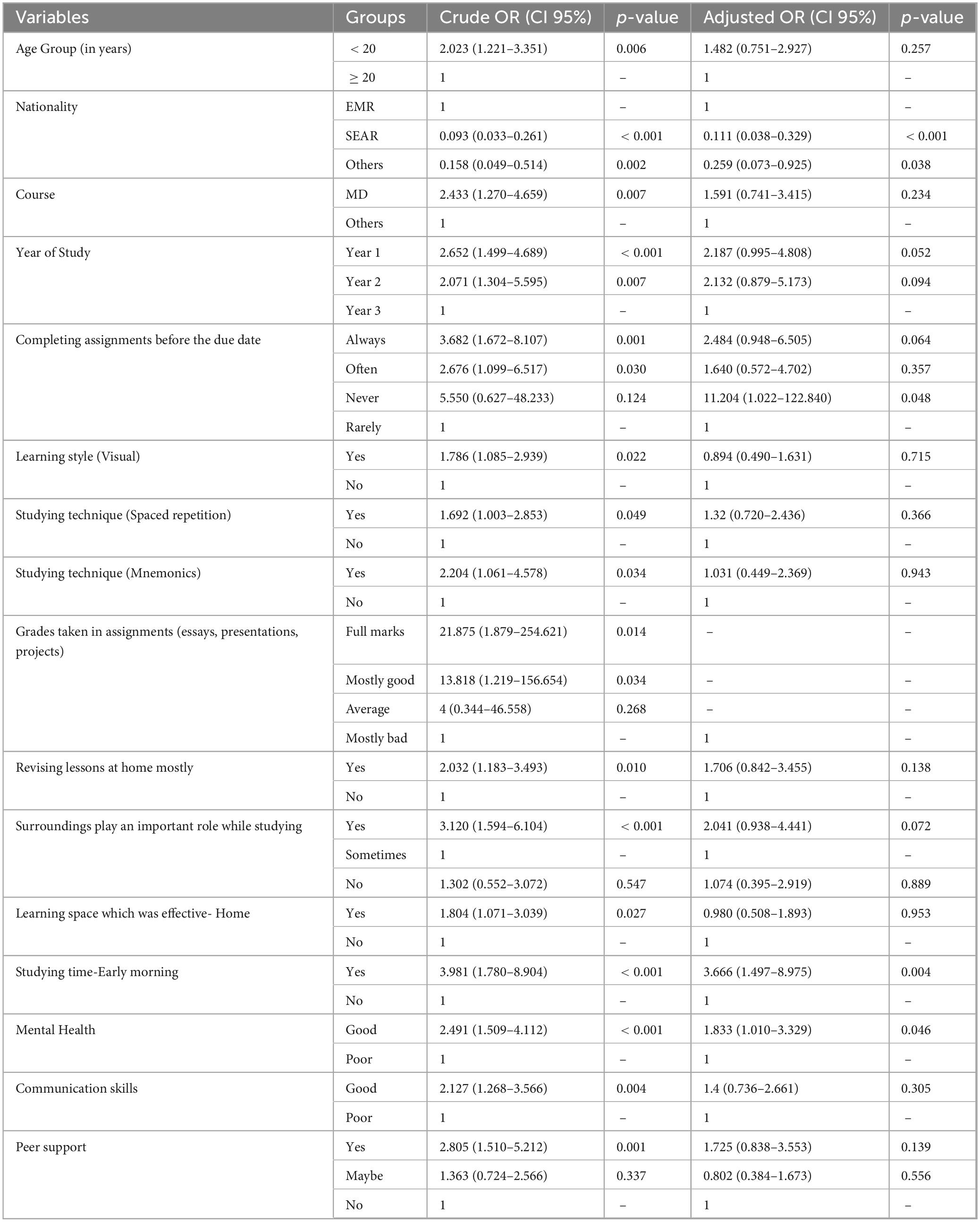- 1College of Medicine, Gulf Medical University, Ajman, United Arab Emirates
- 2Department of Biomedical Science, College of Medicine, Gulf Medical University, Ajman, United Arab Emirates
- 3Department of Community Medicine, College of Medicine, Gulf Medical University, Ajman, United Arab Emirates
- 4Thumbay Institute of Population Health, College of Medicine, Gulf Medical University, Ajman, United Arab Emirates
Background: Learning environments, lifestyle habits, and personal and social factors can significantly influence the academic performance of healthcare professional students. Additionally, individual study approaches may impact their academic outcomes. Understanding these contributing factors is essential for supporting student success and optimizing educational outcomes.
Methods: A cross-sectional study was conducted among 521 healthcare professional students aged 18 and above using a self-administered questionnaire. The survey collected data on socio-demographic characteristics, academic performance (measured by CGPA), learning environments, lifestyle habits, and personal and social influences. Data were analyzed using descriptive and inferential statistics via SPSS version 29.
Results: The study revealed that age, nationality, course of study, and academic year were significantly associated with CGPA, while gender showed no significant association. Most students reported a preference for visual learning styles, the use of active recall as a study technique, and studying primarily at home. Key factors such as mental health status, home-based learning environments, and peer/family support were also significantly associated with higher academic performance.
Conclusion: Multiple factors, including learning styles, study techniques, learning environments, and personal and social influences—can positively or negatively affect the academic performance of healthcare professional students. Addressing these factors through targeted support programs and awareness initiatives is essential to foster academic success and well-being among students.
1 Introduction
The educational setting greatly impacts how well students learn and function academically. Learning spaces including classrooms, laboratories, libraries, and even informal settings like cafes and gardens, play a critical role in teaching and learning. Cumulative Grade Point Average (CGPA) results on standardized tests, goals, and accomplishments during college have all been used to characterize academic performance (Schaughency et al., 2022). A student’s learning environment or space encompasses the various physical spaces, cultural contexts, and learning situations they encounter (BCcampus, 2024). Academic responsibilities and university life introduce a new social and competitive environment. These, in turn, influence a student’s personality, study habits and sleep patterns. Together, these factors can significantly influence academic performance.
According to a study conducted in Jordan among healthcare professional students, 60% of the participants had CGPAs in the excellent or very good range. These students reported sleeping more during exam periods and experienced fewer difficulties staying awake during the day or waking up in the morning compared to those with lower CGPAs (p < 0.05). The study also identified several negative predictors of academic performance, including age, part time employment, smoking, fewer study hours, and daytime sleepiness (Aleidi et al., 2020).
Similarly, a study in South Korea found that involvement in student clubs was significantly associated with absences or delays in academic progress among medical students (p = 0.007) (Chung et al., 2024). Another study examining medical students reported that CGPA was significantly associated with factors such as age, financial status, relationships with cohabitants, and peer interactions (Guerrero-López et al., 2023).
Additional research highlighted that parental concern (87.2%), time spent on social media (78.4%), peer influence (74.4%), the need for a quiet study environment (88.8%), and teaching style (80.8%) were among the most influential factors affecting academic performance. Furthermore, variables like living arrangements, breakfast frequency, academic performance of peers, nighttime study habits, and voluntarily choosing the medical field also showed significant associations with academic success (Khan et al., 2020).
College students also face numerous academic stressors, including heavy course loads, time management challenges, familial expectations, and competitive classroom environments. These stressors can negatively impact academic performance (Barbayannis et al., 2022). Additionally, cognitive and behavioral engagements, such as attending lectures attentively, participating in class activities, and engaging in group assignments have been shown to positively influence academic achievements (Kassab et al., 2024).
The physical learning environment also contributes to academic outcomes. One study found that access to campus green spaces was positively associated with academic achievement, which in turn mediated improvements in students’ mental health. This suggests that the surrounding environment can indirectly affect academic performance as well (Liu et al., 2022).
The existing literature highlights a range of factors that influence academic performance among university students, including stress, mental health, sleep disturbances, club involvement, financial status, social media use (Aleidi et al., 2020; Barbayannis et al., 2022; Chung et al., 2024; Guerrero-López et al., 2023; Kassab et al., 2024; Khan et al., 2020; Liu et al., 2022). However, much of the research has been conducted outside the United Arab Emirates (UAE), where cultural, educational, and institutional contexts may differ significantly. Notably, there is limited evidence on how variables such as learning environments, study techniques and duration, lifestyle habits, and social or personal influences affect their academic performance, particularly among healthcare professional students in the UAE. To address this gap, the present study seeks to identify the key determinants of academic performance within this population. It specifically explores the research question: What are the determinants of academic performance of healthcare professional students in a medical university in the UAE? The study hypothesizes that students’ CGPA is significantly associated with sociodemographic characteristics, learning space conditions, study habits, life style factors, and social influences.
2 Materials and methods
2.1 Study design and study population
A cross-sectional study was conducted among 521 students at a medical university in Ajman, UAE, between February and October 2024. The participants included first-year (n = 301), second year (n = 117) and third-year medical (n = 103) students. They were enrolled in various academic programs such as Doctor of Medicine (MD), Higher Diploma in Pre-Clinical Sciences (HDPCS), Bachelor of Biomedical Science (BBMS), Bachelor of Pharmacy, Bachelor of Dental Surgery (BDS), Master of Dental Surgery (MDS), Bachelor of Physiotherapy (BPT), Bachelor of Science in Nursing (BSN), Master in Public Health (MPH), Master of Science in Drug Discovery and Development (MDD), and Bachelor of Sciences (Anesthesia Technology, Medical Imaging Sciences, Medical Laboratory Sciences, Healthcare Management and Economics).
The exclusion criteria included students who declined to participate, were unavailable at the time of data collection, or were enrolled in the fourth, fifth, or sixth years of study. The sampling strategy aimed to ensure a representative sample of healthcare professional students across diverse academic backgrounds, years of study, and sociodemographic profiles.
2.2 Data collection
The data collection started after receiving approval from the Institutional Review Board of a medical university in Ajman, UAE. All recruited participants remained engaged throughout the study and completed the questionnaire in full, resulting in no dropouts. Participants were approached to fill out the self-administered questionnaire during their break time or after their classes in the medical university. The research tool to determine academic performance was a self-administered questionnaire presented to the participants in the form of a Google form. The questionnaire comprised six main themes: (1) sociodemographic characteristics, (2) academic performance, (3) learning space and potential factors affecting learning, (4) lifestyle-related factors, (5) personal factors, and (6) social factors.
• Socio-demographic characteristics:
The theme of socio-demographic characteristics consisted of factors such as age, gender, nationality, course, academic year, height, and weight of the participants.
• Academic performance:
The academic performance section of the questionnaire included questions related to various study habits and academic indicators. These covered the number of hours spent studying, whether participants reviewed lecture material before class, and whether they revised the content on the same day it was taught. Additional questions assessed the timeliness of assignment completion, instances of last-minute studying, level of attentiveness and class attendance, use of specific study styles or techniques (if any), typical grades received on assignments, any academic achievements earned, and the participants’ usual cumulative grade point average (CGPA).
• Learning space and potential factors associated with learning:
The questionnaire also included items related to the learning environment and potential factors influencing study effectiveness. Participants were asked about their primary study location and whether they believed the surrounding environment impacted their ability to study effectively. They were also asked to describe the temperature and noise levels of their study space. Additional questions explored their preferred study methods, including whether they preferred to study alone or in groups, and whether they studied while listening to music. Participants were specifically asked whether they studied in cafés, as this has become a popular study setting among students, and to examine any potential association with their CGPA.
• Lifestyle factors:
This section explored lifestyle habits potentially affecting academic performance. Participants were asked about their usual study times, average hours of sleep, frequency of sleep-related interference with study, exercise frequency, and dietary habits. They were also asked for their opinion on whether physical activity could improve academic performance.
• Personal and social factors:
In addition to lifestyle-related factors, the questionnaire explored potential personal and social factors that could influence academic performance. Under the theme of personal factors, participants were asked whether they experienced any family-related issues affecting their studies, how effectively they managed their time, and their ability to cope with difficulties without compromising their academic responsibilities. Emotional well-being was also assessed by inquiring how frequently they felt motivated, experienced stress related to academic work, or encountered anxiety during exams or public presentations. Participants were further asked to rate their perceived mental health status.
Under the theme of social factors, participants shared their views on the impact of peer support, family support, extracurricular activities, and the competitive academic environment on their performance. Additionally, they were asked to rate their communication skills and indicate how often they were able to meet their academic expectations.
2.3 Data analysis
After data collection, the data were exported to an Excel spreadsheet and subsequently transferred to the Statistical Package for the Social Sciences (SPSS) version 29 for analysis. Results were presented using frequency tables and descriptive text. The Chi-square test was employed to assess associations between categorical variables. Variables that showed statistical significance in the Chi-square test were included in simple binary logistic regression to determine the degree of association. Those that remained statistically significant in the simple binary logistic regression were further included in multiple logistic regression analysis to identify the net effect of each variable. These variables were considered the predictors of CGPA. A p-value of less than 0.05 was considered statistically significant.
2.4 Ethical considerations
Ethical approval for the study was obtained from the Institutional Review Board of a medical university in Ajman, UAE (Ref. no. IRB-COM-STD-47-FEB-2024). A pilot study was conducted among five medical students from the same target population to refine the questionnaire. Informed consent was obtained from all participants, with the consent form displayed on the first page of the Google Form. Participation in the study was entirely voluntary. The confidentiality, anonymity, and privacy of all participants were strictly maintained throughout the research process.
3 Results
A total of 521 healthcare professional students participated in the study. The majority were under the age of 20 (n = 285, 54.7%), female (n = 405, 77.7%), from the South-East Asia Region (SEAR) (n = 275, 52.8%), and enrolled in the first year of study (n = 301, 57.8%). Most students reported a preference for visual learning styles, employed active recall as a study technique, and identified their home as the primary study space. Sociodemographic variables such as age, nationality, course, and year of study were significantly associated with cumulative grade point average (CGPA), with the exception of gender. Additionally, factors including preferred learning style (visual), study technique, study environment (home), perceived mental health, communication skills, and peer support were also significantly associated with students’ CGPA.
As shown in Table 1, a total of 521 healthcare professional students participated in the study. Participants were grouped into two age categories: below 20 years (n = 285, 54.7%) and 20 years and above (n = 236, 45.3%). The majority of the sample were female (n = 405, 77.7%). Nationality was categorized based on the World Health Organization (WHO) regional classification. Most participants were from the South-East Asia Region (SEAR) (n = 275, 52.8%), followed by the Eastern Mediterranean Region (EMR) (n = 165, 31.7%). Participants from other regions, including the European Region (EUR), Region of the Americas (AMR), African Region (AFR), and Western Pacific Region (WPR), were grouped under “Others,” comprising 81 participants (15.5%). Regarding academic programs, 157 students (30.1%) were enrolled in the Doctor of Medicine (MD) program. The remaining 364 students (69.9%) were enrolled in other healthcare-related programs, including the Higher Diploma in Pre-Clinical Sciences (HDPCS), Bachelor of Biomedical Science (BBMS), Bachelor of Pharmacy, Bachelor of Dental Surgery (BDS), Master of Dental Surgery (MDS), Bachelor of Physiotherapy (BPT), Bachelor of Science in Nursing (BSN), Master in Public Health (MPH), Master of Science in Drug Discovery and Development (MDD), and Bachelor of Sciences (Anesthesia Technology, Medical Imaging Sciences, Medical Laboratory Sciences, and Healthcare Management and Economics). In terms of academic year, most participants were first-year students (n = 301, 57.8%), followed by second-year (n = 117, 22.5%) and third-year students (n = 103, 19.8%).
As shown in Table 2, the majority of participants (n = 386, 74.1%) reported studying less than 4 h per day, while 135 participants (25.9%) reported studying more than 4 h daily. In terms of assignment habits, most participants indicated that they always completed their assignments before the due date (n = 368, 70.6%). Others reported often completing them on time (n = 108, 20.7%), rarely doing so (n = 33, 6.3%), and never completing them before the deadline (n = 12, 2.3%). Regarding academic performance, 235 participants (45.1%) reported a cumulative grade point average (CGPA) between 3.5 and 3.9. This was followed by 131 participants (25.1%) with a CGPA of 3.0 to 3.5, 82 participants (15.7%) with a perfect CGPA of 4.0, 65 participants (12.5%) with a CGPA of 2.0 to 3.0, and 8 participants (1.5%) with a CGPA below 2.0.
The majority of healthcare professional students reported using a visual learning style (n = 327, 62.8%), followed by kinesthetic (n = 206, 39.5%) and auditory (n = 182, 34.9%) learning styles. Notably, many students indicated that they employ more than one learning style simultaneously.
Regarding study techniques, active recall was the most commonly used method (n = 232, 44.5%), followed closely by spaced repetition (n = 227, 43.6%). Other techniques included the Feynman technique (n = 189, 36.3%) and the use of mnemonics (n = 115, 22.1%).
From Table 3, the majority of participants (n = 410, 78.7%) responded “Yes” when asked whether their study environment plays an important role in their academic focus. A smaller portion responded “Sometimes” (n = 54, 10.4%) or “No” (n = 57, 10.9%). Regarding the temperature of their learning space, more than half reported it as “Optimum” (n = 275, 52.8%), followed by “Moderately cold” (n = 154, 29.6%), “Very cold” (n = 46, 8.8%), “Moderately warm” (n = 39, 7.5%), and “Extremely warm” (n = 7, 1.3%). When asked about the noise level in their study environment, most participants selected “Neither loud nor quiet” (n = 185, 35.5%), followed by “Moderately quiet” (n = 166, 31.9%), “Moderately loud” (n = 67, 12.9%), “Too quiet” (n = 62, 11.9%), and “Very loud” (n = 41, 7.9%). Over half of the participants (n = 288, 55.3%) indicated they do not listen to music or natural sounds while studying, whereas 44.7% (n = 233) reported that they do. Additionally, the majority of students (n = 301, 57.8%) stated they usually keep their phone near them while studying. Others reported doing so only “Sometimes” (n = 128, 24.6%), and a smaller group (n = 92, 17.7%) indicated they do not keep their phone nearby while studying.
Regarding learning space, the majority of them reported “home” being the most common learning space (n = 410, 78.7%) followed by library (n = 152, 29.2%), dorms (n = 77, 14.8%), and café (n = 73, 14%).
Table 4 outlines lifestyle factors that may influence the academic performance of healthcare professional students. The majority of participants (n = 498, 95.5%) reported sleeping ≤ 7 h per night, while only a small portion (n = 23, 4.5%) reported getting more than 7 h of sleep. When asked whether their academic responsibilities affect their sleep duration, most participants responded “Only during exams or tests” (n = 206, 39.5%). This was followed by “Almost every day” (n = 163, 31.3%), “Just a few times a month” (n = 116, 22.3%), and “Never” (n = 36, 6.9%). Regarding exercise frequency, a considerable proportion of students reported exercising “Often” (n = 203, 39.0%), followed by “Rarely” (n = 187, 35.9%), “Every day” (n = 83, 15.9%), and “Never” (n = 48, 9.2%).
Table 5 presents personal factors that may influence the academic performance of healthcare professional students. A significant proportion of students (n = 158, 30.3%) reported having no family-related issues affecting their academics, while a comparable number (n = 145, 27.8%) indicated they “Sometimes” experienced such issues. Regarding motivation toward academic tasks, more than half of the participants (n = 277, 53.2%) reported feeling motivated “Sometimes,” followed by “Very often” (n = 133, 25.5%), “Not very often” (n = 89, 17.1%), and “Never” (n = 22, 4.2%). When asked about emotional responses to academic demands, the majority stated they “Sometimes” (n = 337, 64.7%) felt sad or overwhelmed, while others responded “Always” (n = 110, 21.1%) and “Never” (n = 74, 14.2%). Regarding academic stress, nearly half of the students (n = 257, 49.3%) reported feeling stressed “Most of the time,” followed by “Every day” (n = 107, 20.5%), “Rarely” (n = 139, 26.7%), and “Never” (n = 18, 3.5%). Lastly, most participants rated their mental health as “Good” (n = 347, 66.7%), whereas a third reported having “Poor” mental health (n = 174, 33.3%).
Table 6 highlights the social factors influencing the academic performance of healthcare professional students. A large proportion of participants (n = 386, 74.1%) reported having good communication skills with their colleagues, while the remaining students (n = 135, 25.9%) indicated poor communication skills. Regarding peer support, over half of the participants (n = 272, 52.2%) acknowledged that it positively impacts their academic performance. Others responded with “Maybe” (n = 145, 27.8%) or “No” (n = 104, 20%). Similarly, a majority (n = 321, 61.6%) agreed that family support plays a significant role in their academic success, followed by those who responded “Sometimes” (n = 174, 33.4%) and “No” (n = 26, 5%). When asked about the impact of a competitive academic environment, most students (n = 238, 45.7%) reported that it motivates them to study harder. However, some students indicated that it induces stress (n = 163, 31.3%), while others reported that it has no effect on their studies (n = 120, 23%).
Table 7 illustrates the association between socio-demographic characteristics and the cumulative GPA (CGPA) of students. The results indicate that age, nationality, course of study, and year of study were significantly associated with CGPA (p < 0.05), whereas gender showed no significant association. Students below the age of 20 were more likely to achieve a “very good to outstanding” CGPA (n = 256, 89.8%) compared to those aged 20 and above (n = 192, 81.4%). Similarly, participants from the South-East Asia Region (SEAR) had the highest proportion of high CGPA scores (n = 161, 97.6%) compared to students from other WHO regions. Regarding academic programs, students enrolled in the Doctor of Medicine (MD) course had a greater proportion of high CGPA scores (n = 145, 92.4%) compared to students in other courses (n = 303, 83.2%). When comparing students across academic years, those in their first t (n = 267, 88.7%) and second years (n = 104, 88.9%) reported higher CGPA scores compared to third-year students (n = 77, 74.8%).
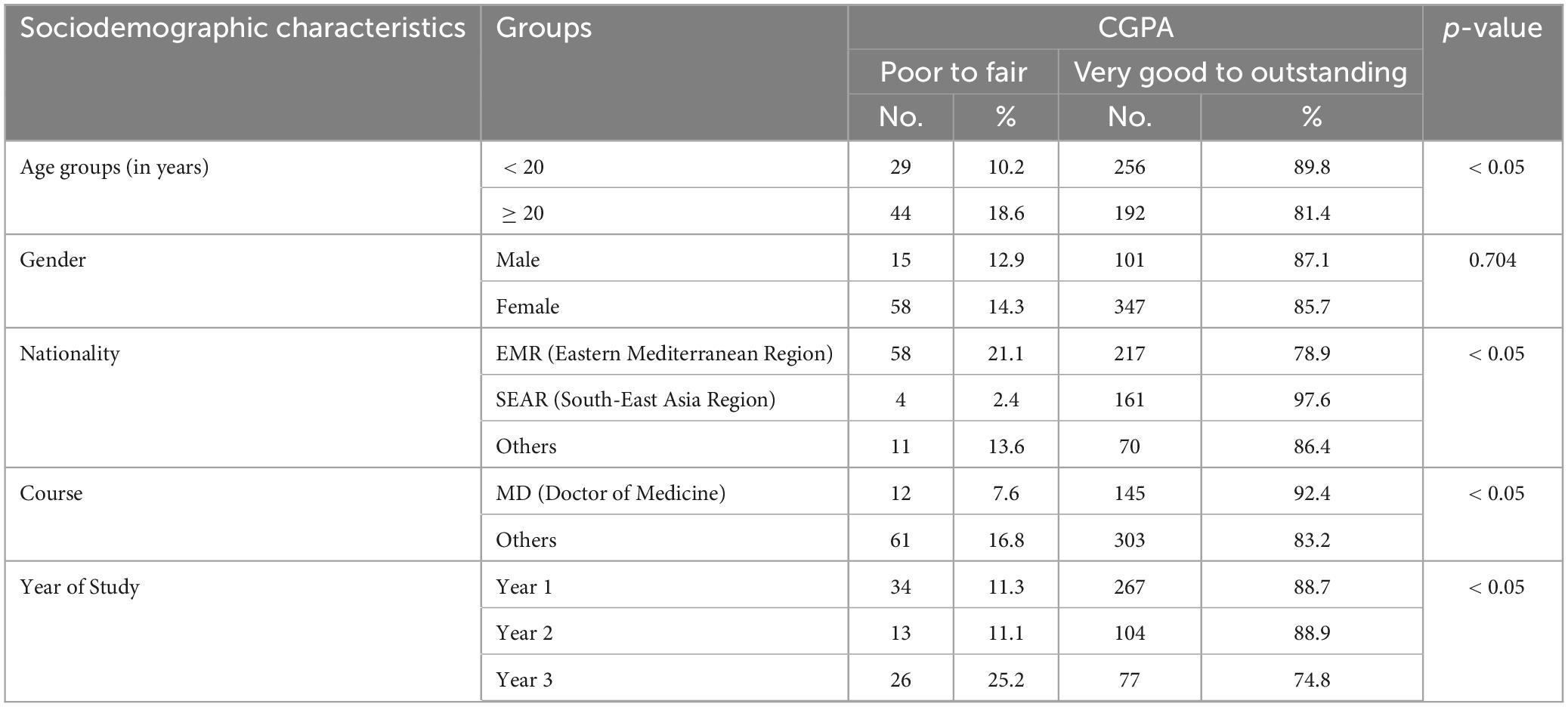
Table 7. Association between sociodemographic characteristics and CGPA of healthcare professional students.
Table 8 demonstrates the association between academic behaviors and CGPA, highlighting that timely assignment completion, visual learning style, specific studying techniques such as spaced repetition and mnemonics, as well as assignment grades, are significantly associated with students’ academic performance.
A higher proportion of students with a “very good to outstanding” CGPA reported that they “always” (n = 324, 88%) or “often” (n = 91, 84.3%) complete their assignments before the due date, compared to those who “rarely” do so (n = 22, 66.7%). This suggests that completing assignments on time positively influences academic performance, as students with higher CGPA scores tend to exhibit this behavior consistently.
The majority of students who identified visual learning as their preferred style also had “very good to outstanding” CGPA scores (n = 290, 88.7%). Furthermore, a greater proportion of students with “poor to fair” CGPA reported not using visual learning (n = 36, 18.6%) compared to those who did (n = 37, 11.3%). These findings indicate that adopting a visual learning style may be positively associated with better academic outcomes.
Similarly, studying techniques such as spaced repetition and mnemonics were more frequently used by students with higher CGPA scores. Among those who used spaced repetition, 89.4% (n = 203) had a “very good to outstanding” CGPA, compared to 83.3% (n = 245) among those who did not. Likewise, 92.2% (n = 106) of students who used mnemonics had high CGPA scores, as opposed to 84.2% (n = 342) of those who did not. These results suggest that incorporating such techniques can be beneficial to academic performance.
Lastly, assignment grades also appeared to be a strong predictor of CGPA. Among students who consistently scored full marks in their assignments, 91.6% (n = 175) achieved a “very good to outstanding” CGPA. Similarly, students who scored mostly good marks (n = 228, 87.4%) and average marks (n = 44, 66.7%) were primarily in the higher CGPA group. Conversely, those who reported scoring mostly poor marks were predominantly in the “poor to fair” CGPA category (n = 2, 66.7%). This implies that consistent academic performance in assignments plays an important role in overall academic success.
Table 9 shows a significant association between students’ learning environments, such as studying at home, the influence of surroundings, and perceptions of effective learning spaces, and their CGPA.
When students were asked where they typically revise their lessons, the majority of those who selected “home” fell into the “very good to outstanding CGPA” category (n = 361, 88%). In contrast, a larger proportion of students with “poor to fair CGPA” indicated that home was not their usual learning space (n = 24, 21.6%) compared to those in the same category who studied at home (n = 49, 12%). This suggests that studying at home, where students have access to their belongings and resources, may enhance focus and support better academic performance.
Similarly, a higher proportion of students who believed that their surroundings play an important role in studying also belonged to the “very good to outstanding CGPA” group (n = 365, 89%). In comparison, students who believed surroundings did not play a role (n = 44, 77.2%) or were uncertain (n = 39, 72.2%) were less likely to be in the higher CGPA group. This indicates that a conducive environment may positively influence study effectiveness and, consequently, academic outcomes.
When asked which learning space they considered most effective, a larger proportion of students with a “very good to outstanding CGPA” chose “home” (n = 338, 88%), compared to those who preferred other spaces (n = 110, 80.3%). This reinforces the notion that many high-performing students perceive home as the most effective environment for focused and productive studying. Thus, the choice and perception of learning space can be an important factor influencing academic performance.
Table 10 presents a significant association between student’s CGPA and various factors including study time, mental health, communication skills, and peer support.
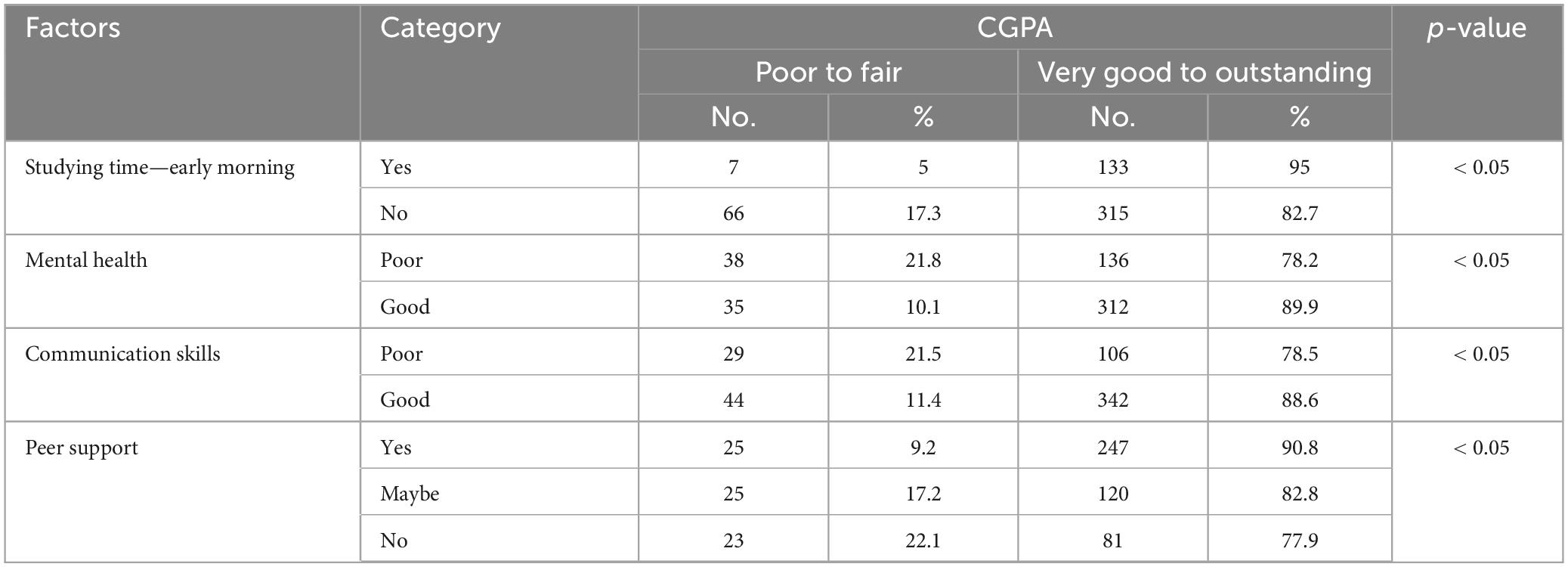
Table 10. Association between factors (such as Lifestyle factors, personal factors, and social factors) and CGPA of the healthcare professional students.
When students were asked about their preferred study time, the majority of those who studied in the early morning belonged to the “very good to outstanding CGPA” group (n = 133, 95%). This suggests that studying during early morning hours may positively influence academic performance.
Regarding mental health, a larger proportion of students with “poor to fair CGPA” reported having poor mental health (n = 38, 21.8%) compared to those with good mental health (n = 35, 10.1%). Conversely, a significant majority of students with “very good to outstanding CGPA” reported good mental health (n = 342, 88.6%). These findings indicate that good mental health may play a crucial role in enhancing academic performance.
In terms of communication skills, students who rated their communication as “good” had a higher proportion of “very good to outstanding CGPA” (n = 342, 88.6%) compared to those with poor communication skills (n = 106, 78.5%). This suggests that effective communication skills may contribute positively to academic success.
Lastly, peer support was also shown to be influential. A greater proportion of students who agreed that peer support plays a role in their academic performance belonged to the “very good to outstanding CGPA” group (n = 247, 90.8%), compared to those who responded “maybe” (n = 120, 82.8%) and “no” (n = 81, 77.9%). This highlights the potential benefit of peer support in achieving strong academic outcomes.
Table 11 presents the results of the adjusted analysis, highlighting several variables that remained significantly associated with students’ CGPA.
Nationality was a significant factor, with students from the SEAR region showing significantly lower odds of achieving a very good to outstanding CGPA compared to those from the EMR region (AOR = 0.111; 95% CI: 0.038–0.329; p < 0.001). Similarly, students from other nationalities also had lower odds compared to EMR students (AOR = 0.259; 95% CI: 0.073–0.925; p = 0.038).
Students who reported studying in the early morning had significantly higher odds of achieving a very good to outstanding CGPA (AOR = 3.666; 95% CI: 1.497–8.975; p = 0.004), indicating a strong positive association between morning study habits and academic performance.
Additionally, good mental health was found to be significantly associated with a very good to outstanding CGPA (AOR = 1.833; 95% CI: 1.010–3.329; p = 0.046), suggesting that students with better mental well-being are more likely to perform well academically.
4 Discussion
4.1 Sociodemographic characteristics and CGPA of the students
Our study found that age, nationality, course, and year of study were significantly associated with academic performance. However, findings from other studies have shown mixed results. For instance, a study conducted in Southeast Nigeria among medical students reported a significant correlation between gender and academic performance, while age was not significantly associated, contradicting the present study’s findings (Ekwochi et al., 2019). Similarly, a study in Saudi Arabia involving undergraduate medical students found no significant association between age, gender, year of study, and academic performance (Agha et al., 2023).
Conversely, a study conducted in Jordan among medical, dental, and pharmacy students identified age, gender, and academic year as factors significantly associated with academic performance. That study also found that most students with outstanding to very good Grade Point Averages (GPAs) were younger (18–21 years) and predominantly female. This differs from our study, in which gender did not show a significant relationship with CGPA (Aleidi et al., 2020).
At a broader level, previous research has indicated that male students tend to perform better than female students at the senior high school level. However, this trend appears to shift at the tertiary level, where female students often demonstrate stronger academic performance compared to their male peers (Wrigley-Asante et al., 2023). Another study reinforced this disparity, reporting higher academic achievement among male students in higher education settings (Eshetu et al., 2024).
These discrepancies may be attributed to differences in academic program structures, workload demands, stress levels, institutional settings, and sample characteristics across the various studies.
4.2 Academic performance and CGPA of the students
Students who “always” complete assignments on are more likely to achieve a very good to outstanding CGPA (88%) compared to those who “often” or “rarely” do so, with CGPA rates 84.3 and 66.7%, respectively. This indicates a strong positive association between timely assignment completion and academic success.
Supporting this, a study on college students found that effective time management positively impacts college students’ study engagement both directly and indirectly, by improving self-control and academic discipline (Fu et al., 2025). Another study conducted during the COVID-19 pandemic reported that students’ who maintained effective learning behaviors such as proper time management and the use of more complex cognitive strategies, were more likely to perform well academically, even under the challenges of remote learning environments (Li et al., 2022). These findings suggest that students with strong time management skills tend to achieve higher CGPA outcomes due to improved focus and sustained academic effort.
The present study suggests that certain learning styles and study techniques, such as visual learning, spaced repetition, and the use of mnemonics, may be associated with improved academic performance. Students employing these methods tend to achieve higher CGPA outcomes, possibly due to enhanced retention and more effective engagement with learning materials. Adopting targeted strategies, particularly those that support long-term memory and visual processing, could therefore positively influence academic achievement.
A study conducted at the College of Medicine, University of Bisha, examined learning preferences among fourth-year students enrolled in a Problem-Based Learning (PBL) curriculum using the VARK model (Visual, Aural, Read/Write, Kinesthetic). The findings revealed a strong preference for kinesthetic (90.5) and auditory (54%) learning styles, with the majority of students (74.6%) favoring a bimodal learning approach, particularly combinations involving auditory or kinesthetic modalities. However, despite these preferences, the study found no statistically significant differences in GPA across different learning styles or learning modality combinations, indicating that academic performance may not be influenced by preferred learning styles in that context (Aboregela, 2023).
Conversely, another study involving nursing students identified a statistically significant relationship between academic achievement and specific learning styles, such as visual learning (Abd El tawab et al., 2023). This suggests that in certain disciplines or educational settings, learning style alignment may have a measurable impact on academic outcomes.
4.3 Learning space and CGPA of the students
This study found that revising lessons at home is significantly associated with higher CGPA among students. Additionally, the majority of participants reported that home serves as an effective learning environment. These findings align with previous research demonstrating a significant relationship between the home environment and academic achievement (Patel et al., 2024; Younas et al., 2020).
Given the limited research specifically examining the role of home as a preferred learning space and its direct impact on academic performance, it is plausible that several underlying factors contribute to students perceiving home as conducive to learning. These may include the presence of family support, a positive and emotionally stable atmosphere, physical comfort, and a sense of security, all of which can foster improved concentration and motivation, ultimately enhancing academic performance.
Our findings highlight the importance of further investigation into the influence of learning environments on student outcomes. Future research should aim to explore the specific characteristics of home settings that contribute to academic success and assess how these factors interact with student behavior and learning preferences.
4.4 Factors influencing the CGPA of the students
Our findings indicate that students who prefer studying in the early morning tend to achieve very good to outstanding academic performance compared to those who do not. One possible explanation is that early risers may dedicate more time to studying, leading to better academic outcomes. This is supported by a study conducted in Jordan by Aleidi et al., which found that students with excellent or very good GPAs studied for significantly longer durations than their peers with lower GPAs (Aleidi et al., 2020). Similarly, a study conducted in India by Priyanka Goel et al. reported that a higher proportion of high-performing students preferred studying in the early morning hours compared to lower-performing students (Priyanka Goel and Rasania, 2020).
In our study, a significantly higher proportion of students with very good to outstanding CGPA reported good mental health compared to those with lower CGPAs (90 vs. 10%, P < 0.05). This finding aligns with prior research. For instance, a study conducted among medical students in Saudi Arabia by Sajida Agha et al. demonstrated a positive correlation between mental well-being and academic performance (Agha et al., 2023). Similarly, Guerrero-Lopez et al. found that higher perceived stress levels were inversely associated with students’ CGPA (Guerrero-López et al., 2023).
Furthermore, one study among college students indicated that those diagnosed with anxiety and depression had significantly lower grade point averages. However, contrasting evidence was reported in another study, which found no significant differences in creativity and cognitive functioning among healthcare university students regardless of their mental health status. Additionally, research has shown that students with stronger academic motivation tend to perform better, as reflected by higher scores or attempts in online assessments (Candidate et al., 2023; Giannouli and Tragantzopoulou, 2023; Stoyanova and Giannouli, 2022).
Developing strong communication skills can benefit students across multiple domains of life, including personal relationships, academic success, and professional advancement (Shah et al., 2020). In this study, communication skills were found to be significantly associated with academic performance, aligning with previous research that reported a weak but positive correlation between communication proficiency and academic success among university students (Amir et al., 2024). However, contrasting findings have been reported in other studies, which found no consistent or statistically significant relationship between students’ communication skills and their academic performance (Shah et al., 2020).
Regarding peer support, this study also found a significant association between peer support and higher academic achievement. Specifically, 91% of students with very good to outstanding GPAs reported having peer support, compared to only 9% in the fair to poor GPA group. This finding is consistent with previous research suggesting that peer support can foster better academic adaptation, enhance learning motivation, and contribute positively to mental well-being (Worley et al., 2023). For instance, Guerrero-Lopez et al. observed that students who maintained strong relationships with peers and housemates had higher GPAs (Guerrero-López et al., 2023). Similarly, a study conducted in Pakistan identified peer academic performance as an influential factor in the academic outcomes of medical students (Khan et al., 2020).
Based on the findings of this study, a statistically significant association was observed between academic performance and several factors, including sociodemographic variables, learning space conditions, lifestyle habits, and personal and social characteristics, excluding gender. Among these, the key predictors identified were nationality, early morning study habits, and mental health status.
These findings are consistent with prior research. For instance, a study by Goel et al. demonstrated a positive correlation between early morning study routines and academic performance (Priyanka Goel and Rasania, 2020). Similarly, multiple studies have reported a strong association between mental health and students’ academic achievement, particularly CGPA (Agha et al., 2023; Candidate et al., 2023; Guerrero-López et al., 2023).
However, regarding nationality as a predictor, findings were mixed. While our study identified nationality as a significant factor, a contrasting result was observed in a study conducted in the United Arab Emirates, which found no significant relationship between nationality and academic performance among undergraduate statistics students (Yousef, 2019). This discrepancy highlights the potential influence of contextual or program-specific factors on academic outcomes and underscores the need for further research in diverse educational settings.
4.5 Limitations
As this study is a cross-sectional study, the results are subjected to many possible biases as the questionnaire was self-administered. One of the potential biases that can mostly influence this study is response bias as it is about their academic performance and its factors that may have influenced the participants to give a socially acceptable response rather than a true response. Additionally, as the study was conducted among the healthcare professional students of just one university it does not represent a broader population of healthcare professional students from various medical backgrounds and also can limit the generalizability of the findings.
5 Conclusion
This study identifies several significant factors influencing the academic performance of medical students. Positive contributors include age, visual learning style, effective study techniques such as spaced repetition and mnemonics, revising lessons at home, and studying early in the morning. Conversely, several factors negatively impact academic performance, such as poor time management, family-related issues, and insufficient sleep during exams or tests. Additionally, mental health challenges and elevated stress levels were found to adversely affect academic outcomes.
In light of these findings, university administrators and academic staff should take proactive steps to raise awareness among students about how these factors can influence their academic performance. To improve students’ academic outcomes and overall well-being, including personal and social aspects, targeted support programs should be developed and implemented. These initiatives should focus on teaching essential skills such as time management, stress reduction techniques, healthy sleep habits, and other coping strategies that enhance academic performance.
Furthermore, this study underscores the need for continued research in areas such as the impact of learning environments and surroundings, as well as the effectiveness of different learning styles and study techniques. These insights could provide valuable guidance for developing future academic support systems that benefit a broader student population.
Data availability statement
The raw data supporting the conclusions of this article will be made available by the authors, without undue reservation.
Ethics statement
The studies involving humans were approved by Institutional Review Board of Gulf Medical University, Ajman, United Arab Emirates (Ref. no. IRB-COM-STD-47-FEB-2024). The study was conducted in accordance with the Declaration of Helsinki. The participants provided their written informed consent to participate in this study.
Author contributions
SM: Conceptualization, Data curation, Formal Analysis, Investigation, Methodology, Visualization, Writing – original draft, Writing – review & editing. SN: Conceptualization, Data curation, Formal Analysis, Investigation, Methodology, Visualization, Writing – original draft, Writing – review & editing. AA: Conceptualization, Data curation, Formal Analysis, Investigation, Methodology, Visualization, Writing – original draft, Writing – review & editing. LS: Project administration, Supervision, Writing – original draft, Writing – review & editing. NN: Project administration, Supervision, Writing – original draft, Writing – review & editing. JS: Project administration, Supervision, Writing – original draft, Writing – review & editing. AS: Project administration, Supervision, Writing – original draft, Writing – review & editing. LN: Project administration, Supervision, Writing – original draft, Writing – review & editing. JM: Conceptualization, Methodology, Project administration, Supervision, Writing – original draft, Writing – review & editing.
Funding
The author(s) declare that no financial support was received for the research and/or publication of this article.
Acknowledgments
We would like to thank all the participants for their willingness to participate in this study.
Conflict of interest
The authors declare that the research was conducted in the absence of any commercial or financial relationships that could be construed as a potential conflict of interest.
Generative AI statement
The authors declare that no Generative AI was used in the creation of this manuscript.
Publisher’s note
All claims expressed in this article are solely those of the authors and do not necessarily represent those of their affiliated organizations, or those of the publisher, the editors and the reviewers. Any product that may be evaluated in this article, or claim that may be made by its manufacturer, is not guaranteed or endorsed by the publisher.
Abbreviations
AFR: African Region; AMR: Region of the Americas; BBMS: Bachelor of Biomedical Science; BDS: Bachelor of Dental Surgery; BPT: Bachelor of Physiotherapy; BSN: Bachelor of Science in Nursing; COVID–19: Coronavirus disease; CPGA: Cumulative Grade Point Average; EMR: Eastern Mediterranean Region; EUR: European Region; GPA: Grade Point Average; HDPCS: Higher Diploma in Pre-Clinical Sciences; MD: Doctor of Medicine; MDD: Master of Science in Drug Discovery and Development; MDS: Master of Dental Surgery; MPH: Master in Public Health; PBL: Problem–Based Learnin; SEAR: South-East Asia Region; SPSS: Statistical Package for the Social Sciences; UAE: United Arab Emirates; VARK: Visual, Aural, Read, and Kinesthetic; WPR: Western Pacific Region.
References
Abd El tawab, S. S., Abdelrahman, S. M., Mohamed, E. A., El hamid, E. A. A., et al. (2023). Self-Directed learning, learner styles and its relation with academic achievement among students at faculty of nursing. Minia Sci. Nurs. J. 14, 114–123. doi: 10.21608/msnj.2024.220969.1072
Aboregela, A. M. (2023). Learning style preference and the academic achievements of medical students in an integrated curriculum. J. Med. Life 16, 1802–1807. doi: 10.25122/jml-2023-0366
Agha, S., Alzayed, A. A., Alfuraih, T. A., Alenazi, F. T., Alomair, M. I., and Masuadi, E. (2023). Association of the academic performance of undergraduate medical students with positive well-being, intelligence, and factors of academic success. Cureus 15:e50077. doi: 10.7759/cureus.50077
Aleidi, S. M., Elayah, E., and Zraiqat, D. (2020). Factors affecting the academic performance of medical, dental, and pharmacy students in Jordan. Jordan J. Pharm. Sci. 13, 169–183.
Amir, M. A. B., Alan, R., Jusoh, N. H. M., and Yaccob, Y. (2024). The level of communication and academic performance among university students. Int. J. Acad. Res. Bus. Soc. Sci. 14, 1315–1324. doi: 10.6007/ijarbss/v14-i8/22499
Barbayannis, G., Bandari, M., Zheng, X., Baquerizo, H., Pecor, K. W., and Ming, X. (2022). Academic stress and mental well-being in college students: Correlations, affected groups, and COVID-19. Front. Psychol. 13:886344. doi: 10.3389/fpsyg.2022.886344
BCcampus (2024). What is a learning environment?. Opentextbc.ca. Available online at: https://opentextbc.ca/teachinginadigitalage/chapter/5-2-what-is-a-learning-environment/ (accessed December 23, 2024).
Candidate, A. B., Patterson, A., Silver Wolf, D. A., Maguin, E., and Beeler-Stinn, S. (2023). Depression and anxiety among college students: Understanding the impact on grade average and differences in gender and ethnicity. J. Am. Coll. Health 71, 1091–1102. doi: 10.1080/07448481.2021.1920954
Chung, E.-K., Yun, H., Yang, J.-H., Shin, M.-H., and Han, E.-R. (2024). Factors associated with academic performance among medical students at a medical school in South Korea: A retrospective cohort study. PLoS One 19:e0296682. doi: 10.1371/journal.pone.0296682
Ekwochi, U., Osuorah, D. I. C., Ohayi, S. A., Nevo, A. C., Ndu, I. K., and Onah, S. K. (2019). Determinants of academic performance in medical students: Evidence from a medical school in south-east Nigeria. Adv. Med. Educ. Pract. 10, 737–747. doi: 10.2147/AMEP.S210557
Eshetu, A. A., Alemu, S., Mulat, A., Abdu, A., Gobezie, B., Muluken, E., et al. (2024). Gender disparity in academic performance in higher education institutions: A case of Wollo University, Ethiopia. Front. Educ. 9:1476112. doi: 10.3389/feduc.2024.1476112
Fu, Y., Wang, Q., Wang, X., Zhong, H., Chen, J., Fei, H., et al. (2025). Unlocking academic success: The impact of time management on college students’ study engagement. BMC Psychol. 13:323. doi: 10.1186/s40359-025-02619-x
Giannouli, V., and Tragantzopoulou, P. (2023). Creativity is not related to higher cognitive functioning: An exploration among healthcare professionals and students during the Covid-19 Omicron wave. SVOA Neurol. 4, 71–78. doi: 10.58624/SVOANE.2023.04.094
Guerrero-López, J. B., Monterrosas, A. M., Reyes-Carmona, C., Arrioja Guerrero, A., Navarrete-Martínez, A., Flores Morones, F., et al. (2023). Factors related to academic performance in medical students. Salud. Ment. 46, 193–200. doi: 10.17711/sm.0185-3325.2023.024
Kassab, S. E., Rathan, R., Taylor, D. C. M., and Hamdy, H. (2024). The impact of the educational environment on student engagement and academic performance in health professions education. BMC Med. Educ. 24:1278. doi: 10.1186/s12909-024-06270-9
Khan, K. W., Ramzan, M., Zia, Y., Zafar, Y., Khan, M., and Saeed, H. (2020). Factors affecting academic performance of medical students. Life Sci. 1:4. doi: 10.37185/LnS.1.1.45
Li, X., Pu, R., and Phakdeephirot, N. (2022). The influence of achievement motivation on college students’ employability: A chain mediation analysis of self-efficacy and academic performance. Front. Psychol. 13:972910. doi: 10.3389/fpsyg.2022.972910
Liu, W., Sun, N., Guo, J., and Zheng, Z. (2022). Campus Green spaces, academic achievement and mental health of college students. Int. J. Environ. Res. Public Health 19:8618. doi: 10.3390/ijerph19148618
Patel, B., Singh, A., and Vaishnav, K. (2024). A review of the relationship between home environment and academic performance among college students. Int. J. Ind. Psychol. 12, 3361–3372. doi: 10.25215/1202.297
Priyanka Goel, M., and Rasania, S. (2020). A study of factors influencing academic performance of undergraduate medical students. Ind. J. Commun. Fam. Med. 6:137. doi: 10.4103/ijcfm.ijcfm_74_19
Schaughency, E., Clifford, A. E., and Carroll, J. L. D. (2022). “Assessment of achievement and learning disabilities,” in Comprehensive clinical psychology, eds R. M. Bagby and M. Sellbom (Amsterdam: Elsevier), 141–166. doi: 10.1016/b978-0-12-818697-8.00158-8
Shah, A. A., Syeda, Z. F., and Naseer, S. (2020). University students’ communication skills as a determinant of academic achievement. OJS 3, 107–114. doi: 10.36902/sjesr-vol3-iss2-2020(107-114)
Stoyanova, S., and Giannouli, V. (2022). Online testing as a means of enhancing students’ academic motivation during the Coronavirus pandemic. Educ. Sci. 13:25. doi: 10.3390/educsci13010025
Worley, J. T., Meter, D. J., Ramirez Hall, A., Nishina, A., and Medina, M. A. (2023). Prospective associations between peer support, academic competence, and anxiety in college students. Soc. Psychol. Educ. 26, 1–19. doi: 10.1007/s11218-023-09781-3
Wrigley-Asante, C., Ackah, C. G., and Frimpong, L. K. (2023). Gender differences in academic performance of students studying Science Technology Engineering and Mathematics (STEM) subjects at the University of Ghana. SN Soc. Sci. 3:12. doi: 10.1007/s43545-023-00608-8
Younas, M., Javaid, M. I., Liu, C., Khalid, S., and Bakar, A. (2020). Effect of home environment on students’ academic achievements at higher level. İlköğr Online 19, 3931–3947. doi: 10.17051/ilkonline.2020.03.735550
Keywords: academic performance, healthcare professional students, learning styles, learning space, United Arab Emirates
Citation: Mohamed Wazil S, Nandagopal S, Abdul Rahim Sanaullah A, Susan Mathew L, Nosseir N, Sreedharan J, Sreejith A, Nabeel Alsaad L and Muttappallymyalil J (2025) Determinants of academic performance of healthcare professional students in a medical university, Ajman, United Arab Emirates. Front. Educ. 10:1554022. doi: 10.3389/feduc.2025.1554022
Received: 31 December 2024; Accepted: 17 June 2025;
Published: 16 July 2025.
Edited by:
Caroline Wekullo, Masinde Muliro University of Science and Technology, KenyaReviewed by:
Vaitsa Giannouli, Aristotle University of Thessaloniki, GreeceOctavian Dospinescu, Alexandru Ioan Cuza University, Romania
Ganesh Kamath Mulki, Manipal University College Malaysia, Malaysia
Copyright © 2025 Mohamed Wazil, Nandagopal, Abdul Rahim Sanaullah, Susan Mathew, Nosseir, Sreedharan, Sreejith, Nabeel Alsaad and Muttappallymyalil. This is an open-access article distributed under the terms of the Creative Commons Attribution License (CC BY). The use, distribution or reproduction in other forums is permitted, provided the original author(s) and the copyright owner(s) are credited and that the original publication in this journal is cited, in accordance with accepted academic practice. No use, distribution or reproduction is permitted which does not comply with these terms.
*Correspondence: Jayakumary Muttappallymyalil, ZHIuamF5YWt1bWFyeUBnbXUuYWMuYWU=
†Present address: Latifa Nabeel Alsaad, Research and Graduate Studies, Mohammed Bin Rashid University of Medicine and Health Sciences, Dubai, United Arab Emirates
‡These authors have contributed equally to this work
 Shahnaz Mohamed Wazil1‡
Shahnaz Mohamed Wazil1‡ Afreen Abdul Rahim Sanaullah
Afreen Abdul Rahim Sanaullah Liju Susan Mathew
Liju Susan Mathew Nermine Nosseir
Nermine Nosseir Latifa Nabeel Alsaad
Latifa Nabeel Alsaad
